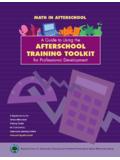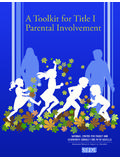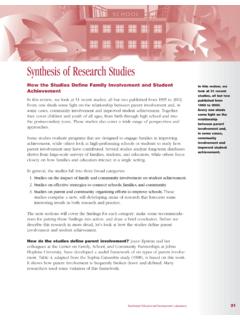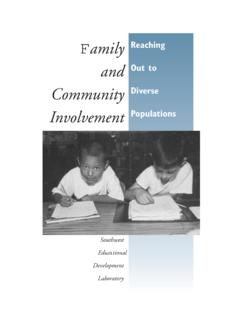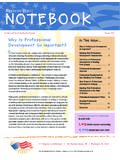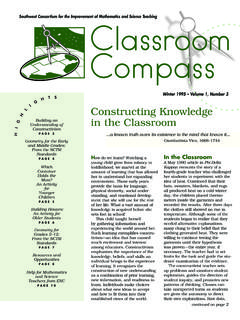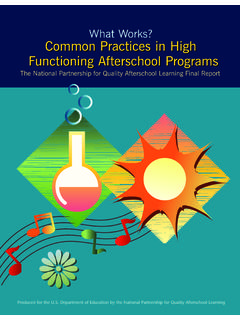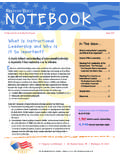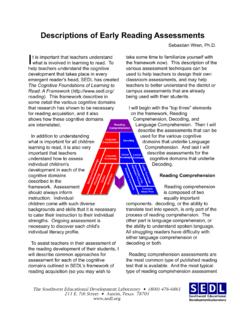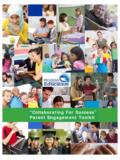Transcription of SEDLinsights - AIR | SEDL - Southwest Educational ...
1 Research, Improving Education Copyright 2014 by sedl insightsSEDLS ylvia Segura Pirtle, PhD, and Ed Tobia, EdDVol. 2, No. 3, Winter 2014D istrict and school leaders seeking to improve student gains are often inundated with well-intentioned programs and supports that promise to produce rapid Determining the best structures, supports, and approaches to advance student learning outcomes while fostering an improved school culture and developing teachers instructional expertise can be a substantial Various researchers have noted that the use of professional learning communities offers an effective, learning-focused process that can foster improvement in teaching and At sedl , we believe that the use of professional learning communities in schools offers a powerful infrastructure where teachers can engage in constructive dialogue, reflect on and improve instruction, and learn how to become more effective in the classroom to improve student learning.
2 In addition, sedl Insights on implementing effective professional learning communities in districts and Provide a clear structure and purpose for PLC meetings2. Address the most pressing instructional challenges3. Provide support from all levels of the school Foster an atmosphere of Monitor the work of PLCs and provide con-structive Support teachers sense of efficacy and level of professionalism. Implementing Effective Professional Learning Communities Professional learning communities, the name given to teachers collaborative professional learning or PLCs, as they are often called has become so overused that the term s meaning is often lost. Only when teachers reflect on their instructional practice, consider the effect instruction has on students, and implement insights gained from a meeting to improve their teaching performance, can this process be called a professional learning community. This issue of sedl Insights explores ways that education leaders can guide their staff in the implementation of effective Pirtle, Pirtle, Cowan, Joyner, & Beckwith, 2012; Harris & Jones, 2010; Hord & Tobia, 2012; Resnick, 2010; The Wallace Foundation, Effective Professional Learning CommunitiesSEDL Insights / Vol.
3 2, No. 3, Winter 20142research indicates there is a strong correlation between the use of effective PLCs in schools and improved teacher learning and instruction and student Through sedl s Center for High-Performing Schools, a program that partners with schools and districts to improve teaching and learning through professional development and technical assistance, we have helped education leaders in South Carolina, Louisiana, and Texas implement PLCs. We have drawn on this experience and recent research on school improvement to identify six insights that can help district and school leaders and teachers implement and sustain the professional learning community the provision of technical assistance to districts and schools, we have observed various types of teacher gatherings that are frequently referred to as PLCs. Such meetings are often a good first step; however to bring effective PLCs to fruition, district and school leaders must focus on increasing teachers collaborative professional learning and self-reflection to improve classroom instruction for enhanced student gains the hallmarks of an effective PLC to which teachers and leaders should aspire.
4 Provide a clear structure and purpose for PLC our work with districts and schools, we have used a structured approach that defines what teachers do in a This approach includes studying standards, reviewing concepts and skills necessary to master the standards, and determining how the standards are assessed; selecting research-based instructional strategies and assessment techniques; planning lessons and agreeing on the evidence of student learning that PLC members will share; implementing lessons, noting successes and challenges, and collecting the agreed-upon evidence of student learning; analyzing student work by revisiting the standards being addressed and identifying student strengths and areas of need; and adjusting instruction after reflecting on disparate teaching experiences, selecting alternative instructional strategies, and determining how instructional challenges that may arise in the future will be help district and school staff develop a clear picture of the collaborative work that teachers do in PLCs, when sedl provides technical assistance through our train the trainer model, we demonstrate the work of PLCs in action and provide intentional, interactive learning tasks.
5 These interactive sessions include modeling the collaborative routines, professional behaviors, and collegial practices that are crucial to holding productive PLC meetings. For example, we have conducted mock PLC meetings where district and school leaders play the roles of teachers. The participants use tools and protocols that support behaviors and practices learned throughout the sessions. This technique helps participants identify key behaviors, practices, and dialogue that foster or inhibit collaboration among PLC members. During these conversations, participants share revelations, questions, and observations about the PLC process. 4 Carroll, Fulton, & Doerr, 2010; Louis, Leithwood, Wahlstrom, & Anderson, 2010; Vescio, Ross, & Adams, Tobia, 2007; Cowan, Effective Professional Learning CommunitiesSEDL Insights / Vol. 2, No. 3, Winter 20143 Additionally, we provide demonstrations on how to hold collegial conversations with peers during PLC meetings.
6 Participants are provided with a scenario, form triads, and take turns playing each of the three following roles: (1) a presenter who describes an aspect of instructional practice or student learning; (2) someone who asks the presenter questions, using questioning, paraphrasing, and probing skills that are crucial to conducting collegial conversations; and (3) an observer who provides feedback to the person asking questions. These tools and practices prepare teachers to become reflective practitioners and active participants in authentic districts and schools implement PLCs, we encourage PLC members to examine formative, benchmark, and state assessment data prior to their meetings. This activity helps them determine the most pressing instructional needs for various groups of students. Using the information gained from the data reviewed, PLC facilitators and members must ensure that a clear purpose for each meeting is established and that all team members are apprised of the priority standards and student expectations to be discussed.
7 When working with districts and schools, we often use authentic student products to demonstrate the process for analyzing student work to determine if students are showing progress toward meeting the priority standard that is the focus of the meeting. Using this process, staff at one school determined that they were teaching a concept using different academic language across grade levels, which created confusion for the students. The staff met to determine collectively the appropriate academic language to use at each grade level and ensure the language was aligned to the content the use of interactive demonstrations, teachers and leaders are able to experience the importance of continuously addressing the most pressing instructional challenges so that students Address the most pressing instructional can be improved. A focus on key instructional challenges encourages teachers to bring samples of student work that provide evidence of student learning to PLC meetings.
8 After analyzing the student work, the teachers have been very deliberate in identifying instructional practices that support or do not support student learning, discussing how to adjust their instruction, and making a plan to better support students in meeting effectively implement and sustain the collaborative work of PLCs, support from all levels of the school system is critical. School and district leaders need to ensure that teachers have adequate scheduled time to meet in PLCs; the necessary resources, technology, and tools to be effective in the classroom; and access to instructional support from within the school, the district, and external technical assistance benefit from assistance from those who can bring specific expertise to PLCs, such as how to analyze data, unpack standards, identify the most effective instructional strategies to address a standard, identify effective assessment strategies, use student work as a reflective tool in PLCs, and adjust instruction to meet student Provide support from all levels of the school system.
9 Implementing Effective Professional Learning CommunitiesSEDL Insights / Vol. 2, No. 3, Winter 20144needs. This critical support can come from principals, instructional specialists, curriculum specialists, and anyone else who can provide technical assistance. Through the Center for High-Performing Schools at sedl , we have coached district and school leaders and specialists on how to best support teachers as they engage in the collaborative work of PLCs. Using a technique called a fishbowl, we model what teachers do in an effective PLC. We select district and school leaders to participate as members of a PLC during the interactive demonstrations and provide them with a facilitators guide so they can replicate the process on their campuses. We also provide videos of effective PLCs that we captured from our work with other districts and schools. We have found that these interactive experiences with district and school leaders afford them the opportunity to experience what teachers do in PLCs.
10 In addition, they provide an opportunity for leaders to brainstorm, reflect, and share successful strategies for continuously supporting the effective implementation of PLCs. District and school leaders and specialists can then use these interactive activities to engage staff at all campuses within the district to provide systemic coherence around the PLC process. 4 InsightThere is mounting evidence of a strong correlation between relational trust in a district and school and student Yet, many well-intentioned school and district administrators initiate the implementation of PLCs while overlooking the shifts necessary to help teachers move from a culture of isolation to a culture that promotes a true collaborative learning organization. To help school and teacher leaders examine the practices that promote trust, we often recommend the book Trust Matters: Leadership for Successful Schools, by Megan The author defines trust as one s willingness to be vulnerable to another based on the confidence that the other is benevolent, honest, open, reliable, and competent.
